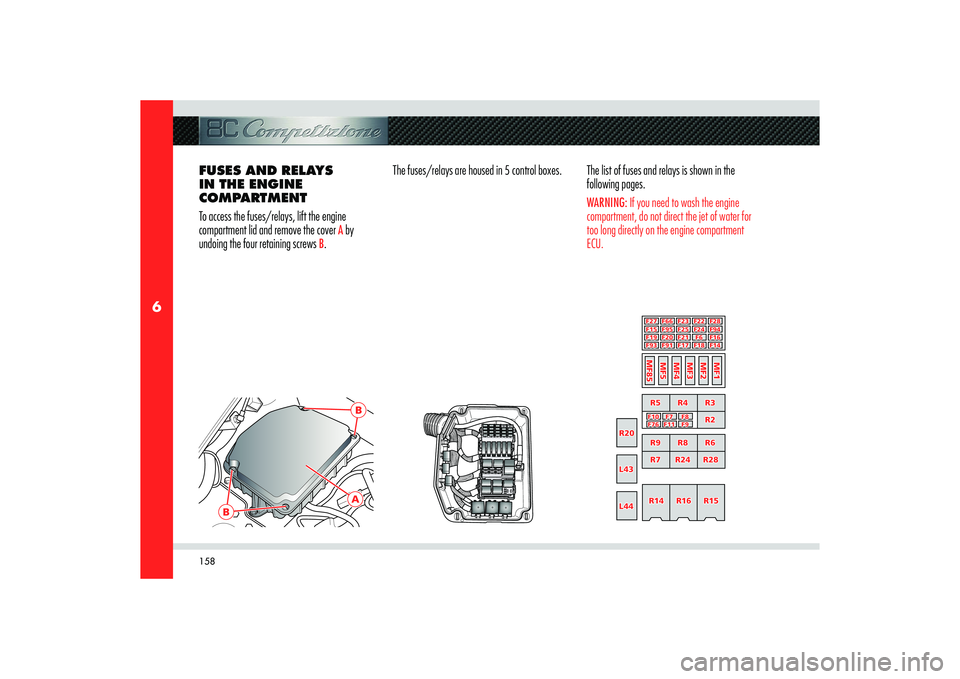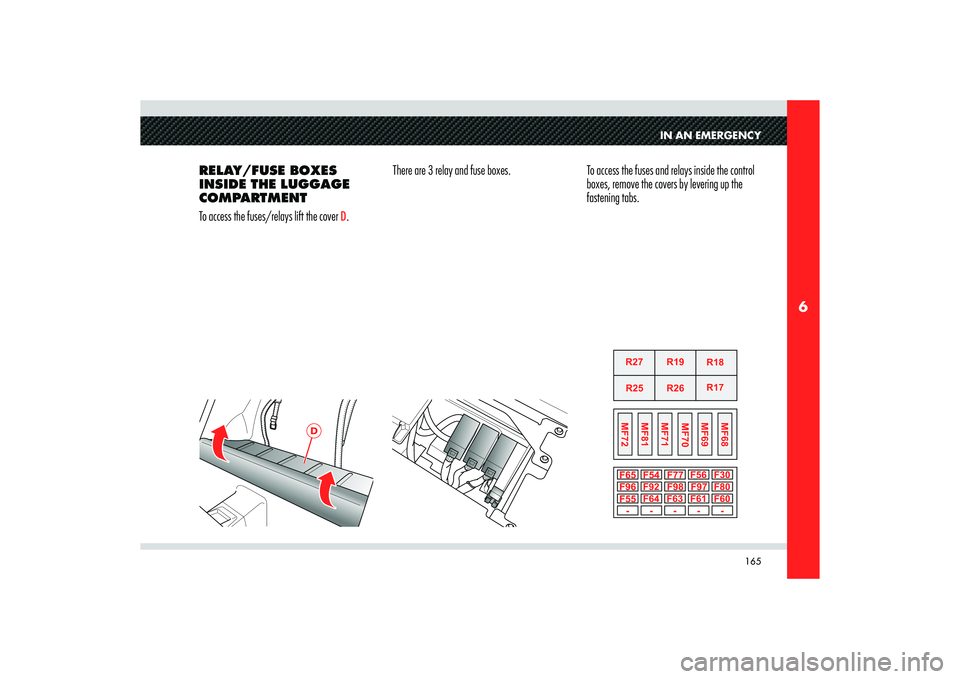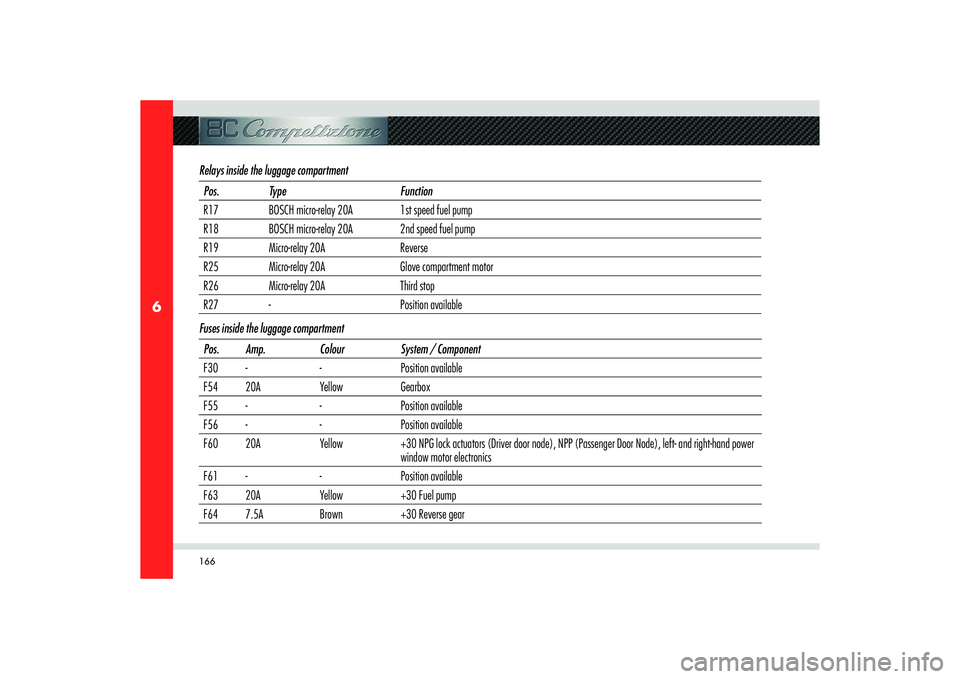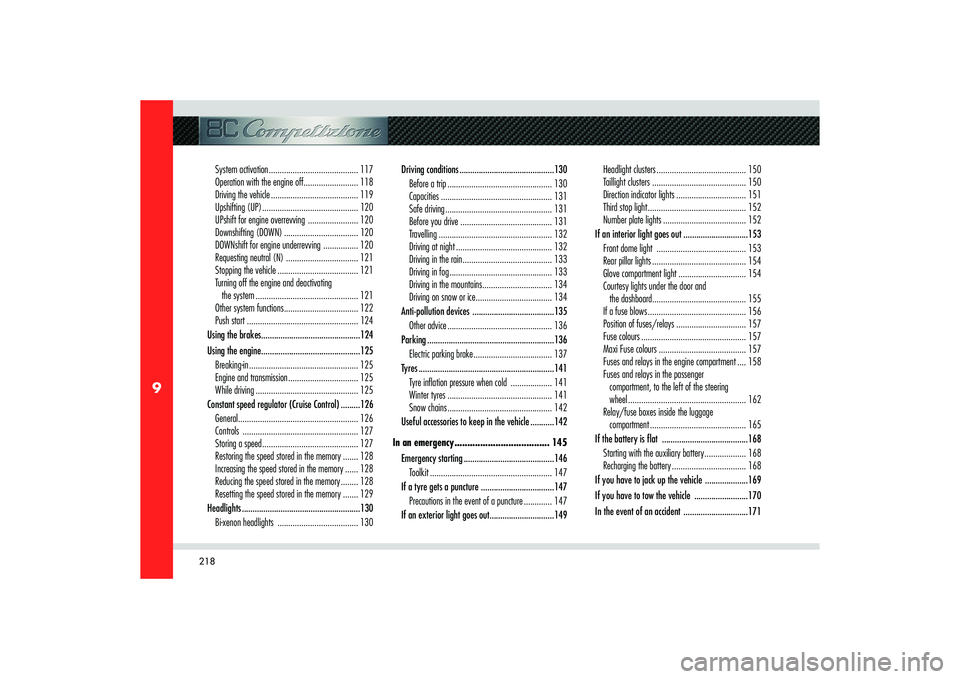fuse box Alfa Romeo 8C 2007 Owner handbook (in English)
[x] Cancel search | Manufacturer: ALFA ROMEO, Model Year: 2007, Model line: 8C, Model: Alfa Romeo 8C 2007Pages: 223, PDF Size: 14.35 MB
Page 160 of 223

158
6
B
AB
F28
F22
F95
F93F15
F23
F8
MF1R6 R8 R9R28 R7R3
R15 R16 R14 R2
0 R20
L43
R4 R5
R2
MF2
MF3
MF4
MF5
MF85
F7 F10
F9 F11 F76F6 F21 F20 F19
F14 F18 F17 F91R24
F27 F66
F94 F24 F25
F16
L43
L44L44
FUSES AND RELAYS
IN THE ENGINE
COMPARTMENT
To access the fuses/relays, lift the engine
compartment lid and remove the cover
A by
undoing the four retaining screws
B.The fuses/relays are housed in 5 control boxes. The list of fuses and relays is shown in the
following pages.
WARNING: If you need to wash the engine
compartment, do not direct the jet of water for
too long directly on the engine compartment
ECU.
Page 162 of 223

160
6
Engine compartment fuses Pos. Amp. Colour System / Component
MF01Maxi 40A Orange +30 ABS (Pump)
MF02Maxi 60A Blue Air pump
MF03Maxi 40A Orange 1
st speed fans
MF04Maxi 50A Red 2nd speed fans
MF05Maxi 40A Orange A/C unit
MF85Maxi 60A Blue +30 front relay and fuse boxes
F0620A Yellow +15 key (Ignition switch)
F0730A Green Injection main relay, main relay coil
F087.5A Brown +30 Injection
F0910A Red +87 main relay I.E.
F1015A Light blue I.E. Secondary devices
F1115A Light blue +87 main relay I.E.
F1410A Red +15 I.E.
F1515A Light blue DRL
F167.5A Brown A.C. Compressor
F1710A Red Left-hand high beam
F1810A Red Right-hand high beam
Page 164 of 223

162
6
C
F-36
F-39
F-38
F-53
F-31F-52
F-41
F-43
F-40
F-44F-45
F-47
F-32
F-50
F-51F-46
F-33
F-37
F-42
F-12F-34
F-48
F-49
F-35
F-13
T01T12
T11T13
FUSES AND RELAYS
IN THE PASSENGER
COMPARTMENT, TO THE
LEFT OF THE STEERING
WHEEL
To access the fuses/relays, turn over the panel
C.The fuses/relays are housed in 2 control boxes. The list of fuses and relays is shown on pages.
Page 167 of 223

165
6
D
IN AN EMERGENCY
RELAY/FUSE BOXES
INSIDE THE LUGGAGE
COMPARTMENT
To access the fuses/relays lift the cover
D.There are 3 relay and fuse boxes. To access the fuses and relays inside the control
boxes, remove the covers by levering up the
fastening tabs.
Page 168 of 223

166
6
Relays inside the luggage compartmentPos. Type Function
R17 BOSCH micro-relay 20A 1st speed fuel pump
R18 BOSCH micro-relay 20A 2nd speed fuel pump
R19 Micro-relay 20A Reverse
R25 Micro-relay 20A Glove compartment motor
R26 Micro-relay 20A Third stop
R27 - Position available
Fuses inside the luggage compartment
Pos. Amp. Colour System / Component
F30 - - Position available
F54 20A Yellow Gearbox
F55 - - Position available
F56 - - Position available
F60 20A Yellow +30 NPG lock actuators (Driver door node), NPP (Passenger Door Node), left- and right-hand power
window motor electronics
F61 - - Position available
F63 20A Yellow +30 Fuel pump
F64 7.5A Brown +30 Reverse gear
Page 207 of 223

205
8
MAINTENANCE
Normal paint maintenance consists in washing,
the frequency of which depends on the
conditions of use and of the environment.
For example, in areas where there is high
atmospheric pollution or if the roads are spread
with anti-freeze salt, it is advisable to wash the
vehicle more frequently. WARNING: Detergents pollute water. Therefore
the vehicle should be washed in areas equipped
for the collection and purification of the fluids
used for washing.For correct washing:
- Wet the bodywork with a low-pressure
water jet.
- Run a sponge soaked in a neutral detergent
solution over the bodywork, remembering
to rinse the sponge frequently.
- Thoroughly rinse with water and dry with a
jet of air or suede.
When drying, take particular care with the parts
that are less visible, such as the door bays, front
lid, headlight edges, in which water can be
trapped more easily. You are recommended not to take the vehicle
immediately into an enclosed environment, but
leave it in the open air so as to allow the water
to evaporate.
Do not wash the vehicle after it has been left in
the sun or when the hood is hot: the paint gloss
could be affected.
External plastic parts must be cleaned with the
same procedure followed for the normal washing
of the vehicle.
Avoid, as far as possible, parking the vehicle
under trees; the resinous substances that very
often drop from the trees give the paint a dull
appearance and increase the possibility of
originating corrosive processes.
WARNING: Bird droppings must be washed off
immediately and thoroughly, since their acidity is
particularly corrosive.
WARNING: To provide better protection for the
paint, polish the vehicle at regular intervals with
a suitable product leaving a protective film on
the paint.
Windows
To clean the windows use special detergents.
Only use clean cloths so as not to scratch the
windows or rendering them less transparent. WARNING: In order not to damage the electric
elements fitted inside the heated rear window,
rub gently following the direction of the
elements. ENGINE COMPARTMENT
At the end of each winter season, carefully wash
the engine compartment, remembering to not
direct the jet of water for too long on the ECUs
and on the relay and fuse boxes on the right-
hand side of the engine compartment (driving
direction). To perform this operation, you must
contact a specialised workshop. WARNING: Wash only when the engine is cold
and with the ignition key turned to STOP. After
washing, make sure that the various protections
(e.g. rubber boots/caps, guards etc.) have not
been removed or damaged.
Page 220 of 223

218
9
System activation ......................................... 117
Operation with the engine off ......................... 118
Driving the vehicle ........................................ 119
Upshifting (UP) ............................................ 120
UPshift for engine overrevving ....................... 120
Downshifting (DOWN) .................................. 120
DOWNshift for engine underrevving ................ 120
Requesting neutral (N) ................................. 121
Stopping the vehicle ..................................... 121
Turning off the engine and deactivating
the system ............................................... 121
Other system functions .................................. 122
Push start ................................................... 124
Using the brakes ..............................................124
Using the engine ..............................................125
Breaking-in .................................................. 125
Engine and transmission ................................ 125
While driving ............................................... 125
Constant speed regulator (Cruise Control) .........126
General ....................................................... 126
Controls ..................................................... 127
Storing a speed ............................................ 127
Restoring the speed stored in the memory ....... 128
Increasing the speed stored in the memory ...... 128
Reducing the speed stored in the memory ........ 128
Resetting the speed stored in the memory ....... 129
Headlights .......................................................130
Bi-xenon headlights ..................................... 130Driving conditions ............................................130
Before a trip ................................................ 130
Capacities ................................................... 131
Safe driving ................................................. 131
Before you drive .......................................... 131
Travelling .................................................... 132
Driving at night ............................................ 132
Driving in the rain ......................................... 133
Driving in fog ............................................... 133
Driving in the mountains ................................ 134
Driving on snow or ice ................................... 134
Anti-pollution devices ......................................135
Other advice ................................................ 136
Parking ...........................................................136
Electric parking brake .................................... 137
Tyres ...............................................................141
Tyre infl ation pressure when cold ................... 141
Winter tyres ................................................ 141
Snow chains ................................................ 142
Useful accessories to keep in the vehicle ...........142
In an emergency ..................................... 145
Emergency starting ..........................................146
Toolkit ........................................................ 147
If a tyre gets a puncture ..................................147
Precautions in the event of a puncture ............. 147
If an exterior light goes out ..............................149Headlight clusters ......................................... 150
Taillight clusters ........................................... 150
Direction indicator lights ................................ 151
Third stop light ............................................. 152
Number plate lights ...................................... 152
If an interior light goes out ..............................153
Front dome light ......................................... 153
Rear pillar lights ........................................... 154
Glove compartment light ............................... 154
Courtesy lights under the door and
the dashboard ........................................... 155
If a fuse blows ............................................. 156
Position of fuses/relays ................................ 157
Fuse colours ................................................ 157
Maxi Fuse colours ........................................ 157
Fuses and relays in the engine compartment .... 158
Fuses and relays in the passenger
compartment, to the left of the steering
wheel ...................................................... 162
Relay/fuse boxes inside the luggage
compartment ............................................ 165
If the battery is � at ........................................168
Starting with the auxiliary battery ................... 168
Recharging the battery .................................. 168
If you have to jack up the vehicle ....................169
If you have to tow the vehicle .........................170
In the event of an accident ..............................171